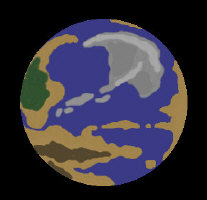Lab 1: Density and Gravity
Extra Questions
These questions can be considered above and beyond the call of duty.
They go a bit further than the main concepts of the lab, so they are
on strictly optional topics. They are mainly designed to let you
investigate some aspects of the lab a bit deeper.
- In lab, we determined the volumes of strange-shaped objects
by placing them in water and observing how much the water level rose.
But what if I have an object that may rust, or dissolve, or get damaged
in some other way if I put it in water? Can you come up with some other
ways to determine its volume?

- As you may recall (at least for density),
the formulae for a planet's density
and for the weight of an object on the planet's surface
(equal to the planet's gravitational pull on the object)
are as follows:


Does a higher-density planet necessarily have a stronger
gravitational pull at its surface?
Or, to put it another way, would it be possible
to have two planets, A and B, such that Planet A is denser
than Planet B, but a 1-kilogram mass will weigh more
on the surface of B than on A?
- Imagine we discover a planet that is a lot like Earth, but it has
one very strange quality: while Earth's continents are made mostly of rock,
one of this planet's continents is made completely of iron.

Imagine repeating the cratering portion of this lab on this new planet,
dropping marbles into pans of sand just as before. You do this on a normal,
rocky continent and on the iron continent (the same distance from the planet's
center at each location). Would the craters you made on the iron continent
be larger, smaller, or exactly the same size as the ones made on the rock
continent? Why?
- We see a lot of craters on the surface of the Moon, but hardly any on
the surface of Earth. Can you think of reasons why this may be?
(It's not because the Moon
does a good job of shielding the Earth from
impactors... if Earth were the size of a baseball, the Moon would be
a ping pong ball about 18 feet away!)

Review Questions...
More Review Questions...
Back to Lab 1.
Back to the main page.




